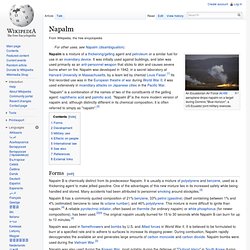

Pyrotechnic composition. A pyrotechnic composition is a substance or mixture of substances designed to produce an effect by heat, light, sound, gas or smoke or a combination of these, as a result of non-detonative self-sustaining exothermic chemical reactions.

Pyrotechnic substances do not rely on oxygen from external sources to sustain the reaction. Basic types of pyrotechnic compositions are: Many pyrotechnic compositions – especially involving aluminium and perchlorates – are often highly sensitive to friction, impact, and static electricity. Even as little as 0.1–10 millijoules spark can set off certain mixtures. Bridgewire. A bridgewire, bridge wire, or hot bridge wire (HBW) is a relatively thin resistance wire used to set off a pyrotechnic composition serving as pyrotechnic initiator.

By passing of electric current it is heated to a high temperature that starts the exothermic chemical reaction of the attached composition. After successful firing, the bridgewire melts, resulting in an open circuit. Usually a thin nichrome wire is used. Some applications also use platinum-silver alloy; other bridgewire materials in use are platinum, gold, silver, tungsten, etc. Care has to be taken when selecting the material as it is in direct contact with the pyrotechnic composition and should not undergo corrosion in such conditions. A shallow notch cut into the center of the bridgewire promotes gross localized overheating instead of homogeneous heating of the entire bridgewire. Bridgewires, especially connected to longer cables, may be susceptible to initiation by currents induced by external electromagnetic fields.[3]
Wildfire. A wildfire is an uncontrolled fire in an area of combustible vegetation that occurs in the countryside or a wilderness area.[1][2] Other names such as brush fire, bushfire, forest fire, desert fire, grass fire, hill fire, peat fire, vegetation fire, and veldfire may be used to describe the same phenomenon depending on the type of vegetation being burned, and the regional variant of English being used.

A wildfire differs from other fires by its extensive size, the speed at which it can spread out from its original source, its potential to change direction unexpectedly, and its ability to jump gaps such as roads, rivers and fire breaks.[3] Wildfires are characterized in terms of the cause of ignition, their physical properties such as speed of propagation, the combustible material present, and the effect of weather on the fire.[4] Characteristics[edit] Causes[edit] Forecasting South American fires.
The most common cause of wildfires varies throughout the world. Fuel type[edit] Napalm. An Ecuadorian Air Force IAI Kfir aeroplane drops napalm on a target during Dominic "Blue Horizon", a US-Ecuador joint military exercise.

Napalm is a mixture of a thickening/gelling agent and petroleum or a similar fuel for use in an incendiary device. It was initially used against buildings, and later was used primarily as an anti-personnel weapon that sticks to skin and causes severe burns when on fire. Napalm was developed in 1942, in a secret laboratory at Harvard University in Massachusetts, by a team led by chemist Louis Fieser.[1] Its first recorded use was in the European theatre of war during World War II; it was used extensively in incendiary attacks on Japanese cities in the Pacific War. "Napalm" is a combination of the names of two of the constituents of the gelling agent: naphthenic acid and palmitic acid. Pyrotechnic initiator. A pyrotechnic initiator (also initiator or igniter) is a device containing a pyrotechnic composition used primarily to ignite other, more difficult-to-ignite materials, e.g. thermites, gas generators, and solid-fuel rockets.

The name is often used also for the compositions themselves. Pyrotechnic initiators are often controlled electrically (called electro-pyrotechnic initiators), e.g. using a heated bridgewire or a bridge resistor. They are somewhat similar to blasting caps or other detonators, but they differ in that there is no intention to produce a shock wave. Detonator. Top: small nonel detonator with 25ms delay for chaining nonel tubes, middle: class B SPD detonator, bottom: class C SPD detonator A detonator is a device used to trigger an explosive device.

Detonators can be chemically, mechanically, or electrically initiated, the latter two being the most common. Other materials such as DDNP (diazo dinitro phenol) are also used as the primary charge to reduce the amount of lead emitted into the atmosphere by mining and quarrying operations. Old detonators used mercury fulminate as the primary, and it was often mixed with potassium chlorate to yield better performance. Types[edit] Electrical[edit] There are three categories of electrical detonators: instantaneous electrical detonators (IED), short period delay detonators (SPD) and long period delay detonators (LPD). Bomb. Liquid fire. Liquid fire may refer to:

Greek fire. Greek fire in use against another ship.

Greek fire was an incendiary weapon used by the Eastern Roman (Byzantine) Empire. The Byzantines typically used it in naval battles to great effect as it could continue burning while floating on water. It provided a technological advantage, and was responsible for many key Byzantine military victories, most notably the salvation of Constantinople from two Arab sieges, thus securing the Empire's survival. The impression made by Greek fire on the west European Crusaders was such that the name was applied to any sort of incendiary weapon, including those used by Arabs, the Chinese, and the Mongols.